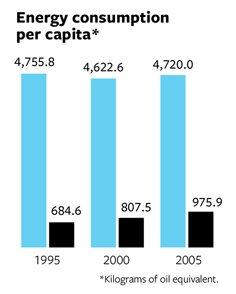The long drama of whether or not the US Congress would invest in international efforts to curb global warming pollution or gut these investments is finally over – at least for the rest of this fiscal year. Last week President Obama signed into law a budget for the rest of this fiscal year (fiscal year 2011). Investments in international climate activities fared alright. The final bill would fund core international climate activities at $750-950 million, with other activities potentially adding to this total. This is a continued investment in these critical programs, but still far away from the ultimate need.
As others have pointed out there is good, ok, and bad news. This budget could have been much, much worse as the original House Republican passed bill would have gutted these critical investments by zeroing out some of the funding levels. In addition, the House Republican version would have eliminated funding to help the best scientists in the world document and communicate the science behind carbon pollution (effectively having the house Republicans pretending global warming doesn’t exist and muffling the scientists that would tell them otherwise). Thankfully that provision wasn’t included.
On the rest of the funding picture it is a mixed story. So let’s look at the numbers in a bit greater detail (I’ll compare to last year’s amount and the President’s request where possible*).
Total investments are slightly down from last year and down a fair amount from the President’s request. Last year’s budget included about $1 billion in funding for core international climate action. On top of that the US State Department reported that other US funding which supports international climate action would bring the total to $1.3 billion ($1.7 billion if you count support provided by US export credit agencies).** For this year the President requested $1.3 billion in core funding (not including the additional programs produce climate action as a co-benefit). The House Republicans would have gutted this funding. The final bill approved $750-950 million in core climate funding, so it is 5-25% below last year’s amount.
Making climate change a priority could lead to $950 million of funding. The final total funding for core international climate action could be very close to last year’s levels, but only if the Administration makes climate change a priority in its final allocation of bilateral assistance funding.*** If the Administration decides that global warming funding is a high priority and allocates the bilateral assistance at a level close to the President’s request then the total ($950 million) will be pretty close to last year’s amount. If they don’t make it this level of a priority then the funding ($750 million) will be significantly below last year’s amount. The ball is in their court. We hope that they’ll allocate the full amount that they requested as international climate investments are in the US interest.
Investments in deploying clean energy were cut, but not as bad as the House Republicans would have cut them. The US funds global efforts to deploy clean energy through bilateral and multilateral assistance – with the largest chunk of multilateral assistance going through the Clean Technology Fund. Unfortunately the clean energy investments through the Clean Technology Fund were cut from $300 million in last year’s budget to $185 million in this year’s budget (a cut of over 50% from the President’s request and 38% below last year’s amount. The House Republicans proposed to completely zero out the Clean Technology Fund so it could have been worse. The Clean Technology Fund is supporting such projects as wind development in Mexico, geothermal in Indonesia, and large-scale solar in North Africa. Bilateral clean energy funding could fare not too bad if the Administration prioritizes it in their allocation of bilateral assistance.***
Support for deforestation investments are about what they were last year as long as the Administration prioritizes them in the final allocations. Last year the US invested $241 million in direct programs to reduce deforestation emissions (called “sustainable landscapes” in the US budget descriptions). In addition the US has continued to fund biodiversity efforts, many of which have deforestation reductions as a co-benefit. In this year’s final budget the amount of core deforestation reduction funding is about $236 million, but could be higher if they allocate bilateral funding with deforestation getting a higher amount. Additional money to reduce deforestation might also be mobilized through biodiversity programs and the Millennium Challenge Corporation which is currently considering funding deforestation reduction efforts in Indonesia.
This funding must be the floor. These investments are in the US interest as they create clean energy opportunities, reduce deforestation emissions, and reduce future instability throughout the world. The Administration has the ability to ensure that the damage of these cuts is minimized by ensuring that the final allocations of bilateral assistance prioritize international climate action. This will be critical.
But we must also begin the fight to ensure that next year’s budget increases funding from this floor. Hopefully President Obama and Congress will restore these cuts as the President’s budget request envisioned scale-up resources for these investments. No rest for the weary.
——————–
Thanks to Michael Wolosin at the Climate Advisors for the detailed breakdowns on the deforestation reduction efforts and Eric Haxthausen at The Nature Conservancy who has a good blog on the budget with some more numbers.
—
* Note that the full breakouts aren’t yet available as the budget that is passed doesn’t break out the spending for all the programs that the US had funded in the past. The final values for some categories depend on how the Administration allocates some funds amongst the various programs.
**All the values below are based on the “core” climate funding as it isn’t clear at this stage how the other programs will be implemented.
*** Funding for a number of the US programs comes through general bilateral assistance accounts which took cuts in the final bill. The “Development Assistance” account which funds most of these programs was passed at roughly last year’s levels. The “Economic Support Fund” which funds a
couple of these programs was passed with a 29% cut from last year’s levels.



